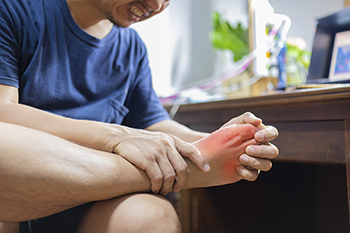
Plantar fasciitis, the inflammation of the tissue on the bottom of your foot, causes heel pain and discomfort and often worsens with physical activity. Risk factors include activities stressing your heel, being overweight, pregnant, or having high arches. Beyond heel pain, symptoms of plantar fasciitis include aching, burning, or swelling. This discomfort is typically most pronounced in the morning or after prolonged sitting, standing, or activity. Causes vary from playing sports to being on your feet a lot, poor arch support, or tight calf muscles. Treatment involves rest, wearing supportive footwear, using orthotics, and stretching the affected area. In severe cases, steroid injections or surgery might be considered. Prevention includes maintaining a healthy weight, wearing supportive shoes, warming up before exercise, and allowing recovery between physical activities. If you have heel pain and suspect you might have plantar fasciitis, it is suggested that you make an appointment with a podiatrist for a proper diagnosis and treatment.
Plantar fasciitis is a common foot condition that is often caused by a strain injury. If you are experiencing heel pain or symptoms of plantar fasciitis, contact one of our doctors from New England Foot & Ankle . Our doctors can provide the care you need to keep you pain-free and on your feet.
What Is Plantar Fasciitis?
Plantar fasciitis is one of the most common causes of heel pain. The plantar fascia is a ligament that connects your heel to the front of your foot. When this ligament becomes inflamed, plantar fasciitis is the result. If you have plantar fasciitis you will have a stabbing pain that usually occurs with your first steps in the morning. As the day progresses and you walk around more, this pain will start to disappear, but it will return after long periods of standing or sitting.
What Causes Plantar Fasciitis?
- Excessive running
- Having high arches in your feet
- Other foot issues such as flat feet
- Pregnancy (due to the sudden weight gain)
- Being on your feet very often
There are some risk factors that may make you more likely to develop plantar fasciitis compared to others. The condition most commonly affects adults between the ages of 40 and 60. It also tends to affect people who are obese because the extra pounds result in extra stress being placed on the plantar fascia.
Prevention
- Take good care of your feet – Wear shoes that have good arch support and heel cushioning.
- Maintain a healthy weight
- If you are a runner, alternate running with other sports that won’t cause heel pain
There are a variety of treatment options available for plantar fasciitis along with the pain that accompanies it. Additionally, physical therapy is a very important component in the treatment process. It is important that you meet with your podiatrist to determine which treatment option is best for you.
If you have any questions, please feel free to contact our offices located in Wakefield, MA, Nashua and Derry, NH . We offer the newest diagnostic and treatment technologies for all your foot care needs.





